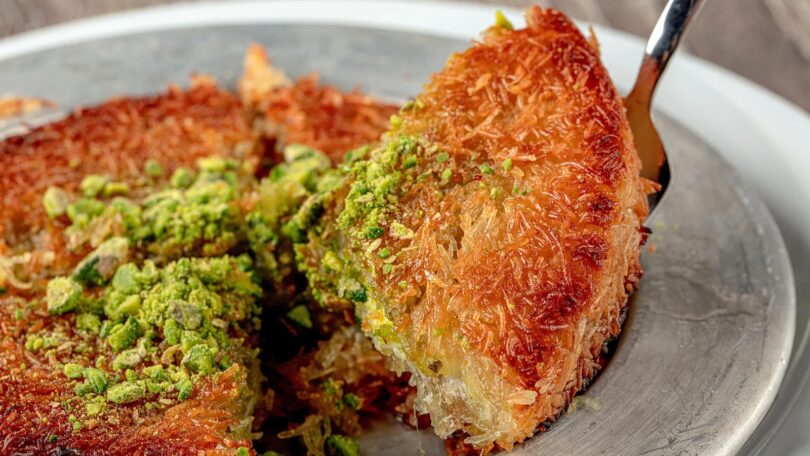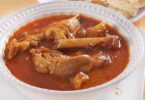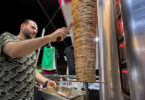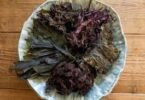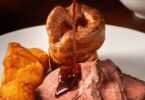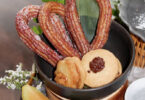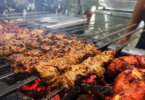It was an early November evening in downtown Hatay, Turkey’s southernmost province bordering Syria. The weather was warm, with pleasant, everlasting breezes. Just having finished up an assignment, I met up with a fellow journalist in the old town. After some kebab, meze and many rakis, stopping at a künefe shop to indulge in the cheesy Levantine dessert was our best option for ending a perfect night.
The künefe’s thin, string-like strands of crunchy semolina dough called tel kadafıy combined with its unsalted stretchy Hatay cheese provided an ideal contrast of textures, while the sherbet (a syrup made of water, sugar and lemon juice) that was poured on top lingered in our mouths.
While a similar dish, knafeh, is found throughout the Middle East, künefe is distinctly Turkish, believed to have originated in Hatay and made specifically with the province’s namesake cheese, which is similar to fresh mozzarella. Traditionally eaten during Ramadan, the dessert can now be found in shops any time of year; in Hatay, more than 30 künefe shops lined the streets, a testament to its popularity.
One could say the dessert’s mixture of tastes and textures is a metaphor for the province, a historical trade centre and melting pot for people from different ethnic and religious backgrounds. And in a food-loving place where people ask you if you’re hungry before they ask your name, dishes like künefe are a point of local pride.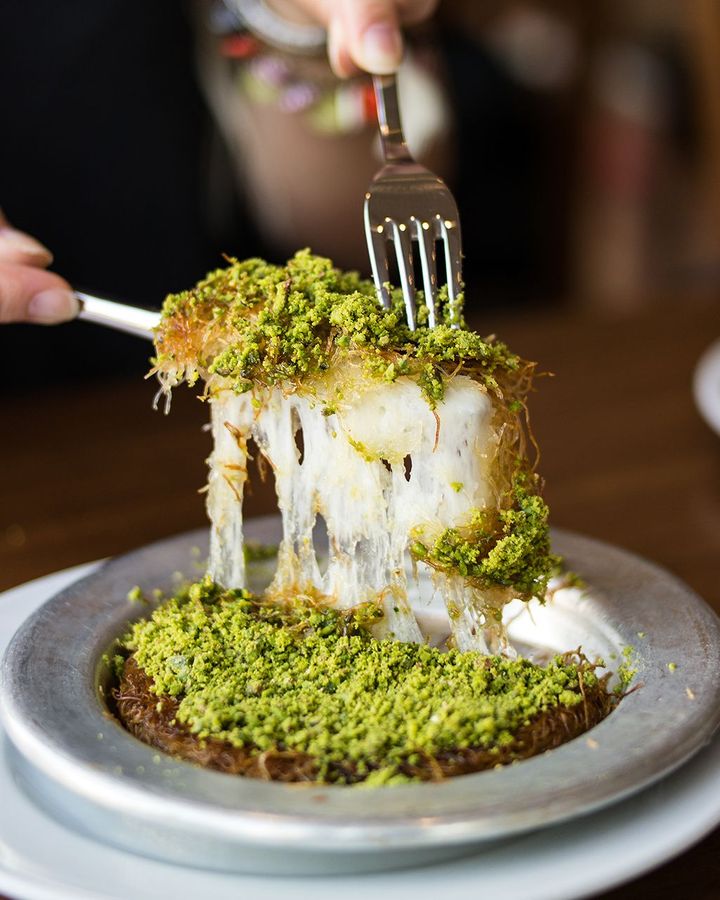
Hatay cheese is similar to fresh mozzarella (Credit: alpaksoy/Getty Images)
The owner of the shop smiled at us while leaning against the door. “Those who taste our food cannot abandon them,” he said. “Remember your first time. You tasted our food, got used to it, and now you can’t give [it] up. Once you come to Antakya, you are bound to return.”
My next visit to Antakya came three years later, but the scene was drastically different.
The square where I first ate künefe was covered with rubble. The once-pleasant air was filled with dust from ongoing excavation work. And a statue of a künefe master – a symbol of the square – was standing alone amid all the destruction.
Turkey and neighbouring Syria had been hit by two major earthquakes (registering 7.8 and 7.5 on the official magnitude scale) in the early hours of 6 February. More than 50,000 people lost their lives, and more than two million people were displaced.
Hatay was one of the region’s worst-hit provinces with almost all its city centre and many of its villages destroyed. More than two months after disaster struck, many people are still in dire need of access to clean water, as well as food, clothing and other necessities.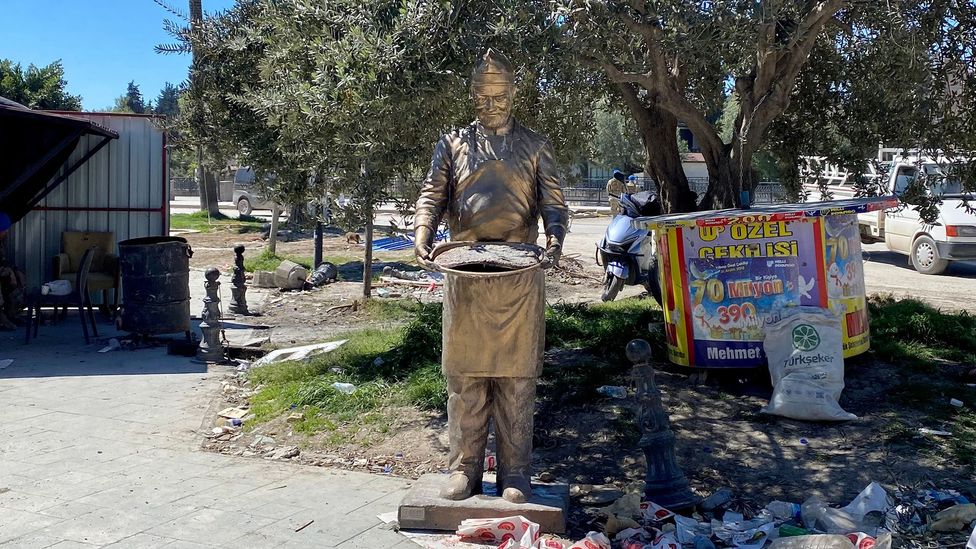
A statue of a künefe master stands alone amid Hatay’s post-earthquake destruction (Credit: Gonca Tokyol)
Yet, in a city where almost everyone lost family members and friends, life continues. A limited number of künefe shops managed to reopen their doors, providing a taste of normalcy to their resilient customers as they rebuild – something locals here have done for centuries.
These recent earthquakes were not the first disaster to strike the area known locally as Antioch or Antakya (due to its historical name), which was the capital of several empires since the death of Alexander the Great. Dr A Asa Eger, an associate professor of the Islamic world at the University of North Carolina, and Andrea U De Giorgi, an associate professor of Classical studies at Florida State University, described the city’s resiliency as “something quintessentially Antiochene” in their 2021 book Antioch: A History, after stating that it had witnessed about 10 earthquakes in its history causing extreme damage and loss of life.
“Yet the city has survived period after period,” Eger and De Giorgi wrote. “Studying Antioch during all of its ages, replete with crises and transformations, teaches us a valuable lesson on the capacity of a city and its citizens to rebuild and to be resilient.”
According to the book, even though disasters had profound physical and psychological effects on the population, they somehow allowed Antioch to reshape, too.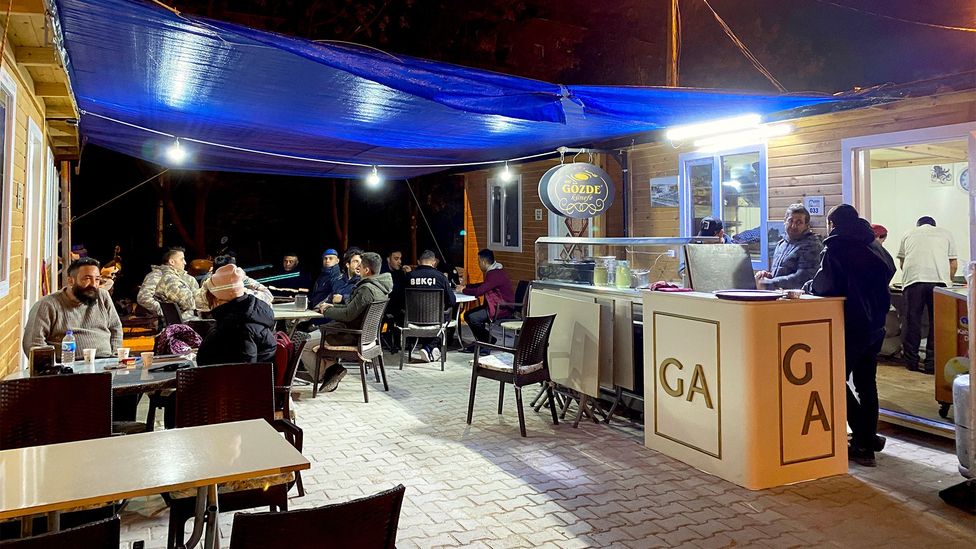
Gözde Künefe reopened in a prefabricated bazaar in Hatay several weeks after the recent earthquakes (Credit: Gonca Tokyol)
Engin Dinç, a künefe master who reopened his heavily damaged shop in a prefabricated bazaar in Hatay several weeks after the recent earthquakes, experienced this first-hand. “It’s a bit small after our old place,” he said. “Still, it’s cute. We are lucky that we had it. Maybe it’s going to be the place where we rear up again.”
Gözde Künefe’s original shop was in one of the wealthier neighbourhoods of Hatay. Customers remembered that some nights before the earthquake, they waited for their orders while cruising the street in their cars since there were no tables to sit at or a parking space to stop at. Now, the new, temporary shop is barely larger than 10sq m, and the staff needs to work efficiently to prevent chaos in the limited space.
While spreading the eze – a paste containing molasses and butter – to the bottom of the round copper trays used for making the künefe, Dinç explained that after years of working for others, he was enjoying being the “boss behind the cash box” before the earthquake versus making the dessert himself as he used to do. “But our master [künefe maker] died with his whole family in the earthquake,” he said. “So, I returned to the back of the counter.”
This time, however, he had a new helper: Lamia Dinç, his wife. After noticing that her husband was struggling to deal with the kitchen and the customers simultaneously, she rolled up her sleeves and became the team’s newest member.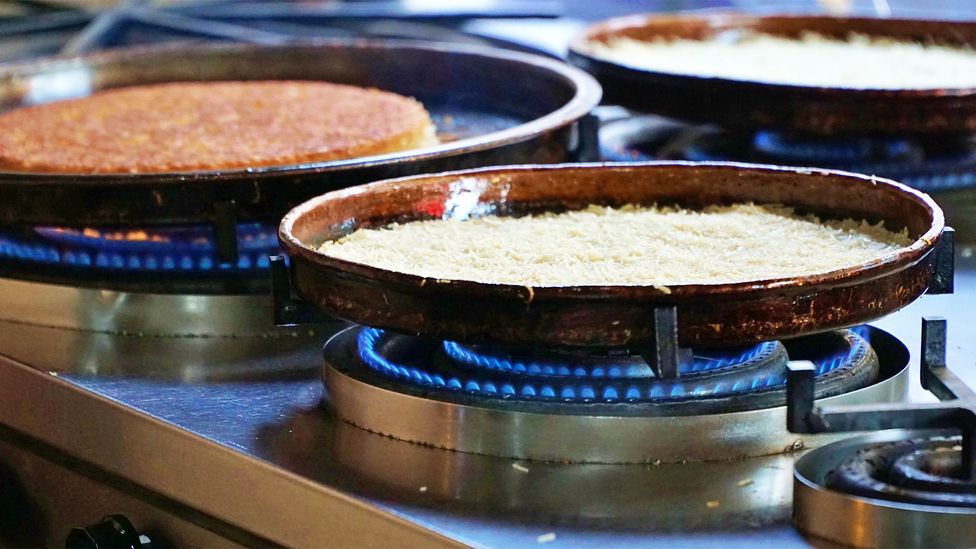
Stoves have a unique mechanism for rotating künefe to ensure even cooking (Credit: YONCA60/Getty Images)
“In the beginning, he didn’t trust me,” Lamia recalled from her first day helping to press the tel kadafıys into eze-lined trays to go onto the stove, which has a unique mechanism for rotating the künefe to ensure even cooking. “But he quickly realised that we need to adapt to the new circumstances to survive,” she continued. “And that’s what we are doing.”
For her husband, returning to the kitchen and completing the first tray of künefe was the first time he felt “good” again after the earthquakes. “I tasted it, and it was the first künefe I ate after what happened,” he remembered. “I said, oh well, I’m alive.”
I said, oh well, I’m alive.
Artisan cheese maker, Lale Kuseyrioğlu, reflected on how life revolves around food – particularly local dishes like künefe – in Antakya while talking about the city before the earthquakes. “The question which finds meaning around Antakya was what would we eat, what would we drink,” she said.
Born and raised in Istanbul and having studied in the UK before moving to Antakya in 2014, Kuseyrioğlu now produces the area’s local Hatay cheese, a soft rindless cheese made from raw goat’s – and sometimes cow’s – milk. She was initially surprised by the city’s connection with food and the people’s passion for spending hours gathered around large dining tables.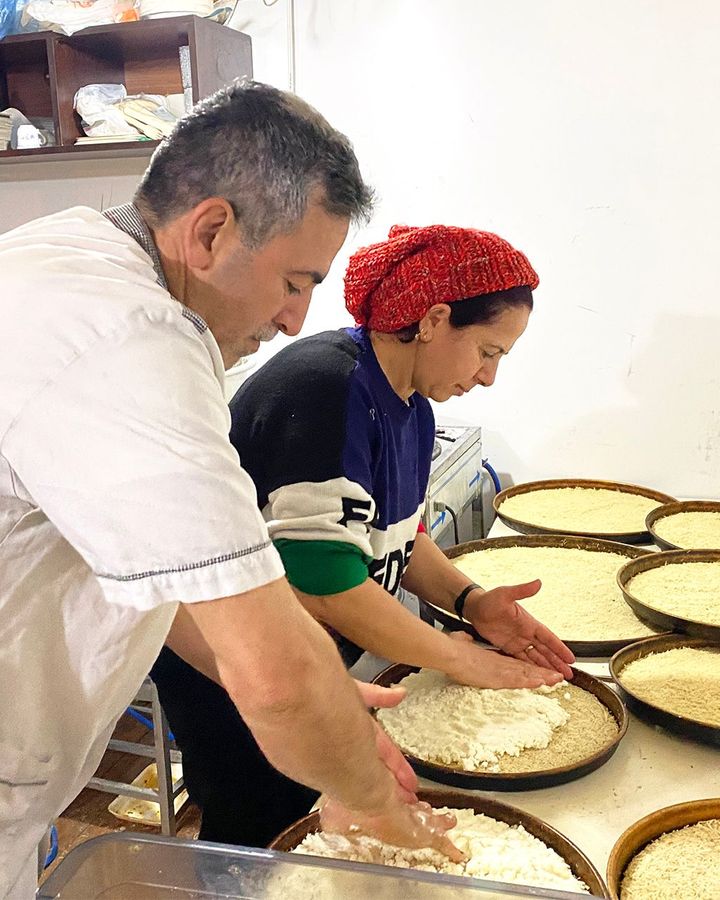
Engin Dinç and his wife, Lamia, make künefe in Hatay after the earthquakes (Credit: Gonca Tokyol)
“I realised that even old mosaics in Antakya were about feast tables when I started to learn more about the city,” she recalled. “The food is the love language for Antakya’s people. They like having everybody over in the evenings, setting big tables with different kinds of food, and spending hours loud mouthing.”
And the künefe was “the sweetest way” to end a meal, according to Kuseyrioğlu. “Normally, it’s not possible to eat any dessert with raki,” she explained while talking about the anise-flavoured Turkish national spirit. “But since künefe has cheese in it, it goes along well with raki. This means that [drinking continues] with the dessert, and the night improves to a delicious ending.”
Since men primarily made it, “künefe was also a bravado tool for them,” Kuseyrioğlu continued. “There were discussions or braggings about the best künefe or style among the men in the same communities.”
Back at Gözde Künefe, however, there was only camaraderie among the Dinç couple. The künefe rotating on stoves created a sizzling sound, and the smell of caramelised butter and molasses filled the air. “It smells like old days,” said one of the local customers sitting outside.
Most of Gözde Künefe’s customers now are people in uniform from the security forces, who are the only ones who can really afford to buy künefe in a city where most of the people no longer have jobs and are dependent on aid and donations. Yet, residents who come back to collect what belongings they can from their homes also visit, and being able to eat künefe “makes them so happy”, Dinç said, while taking trays lined with tel kadayıfs off the stove and putting them aside to cool.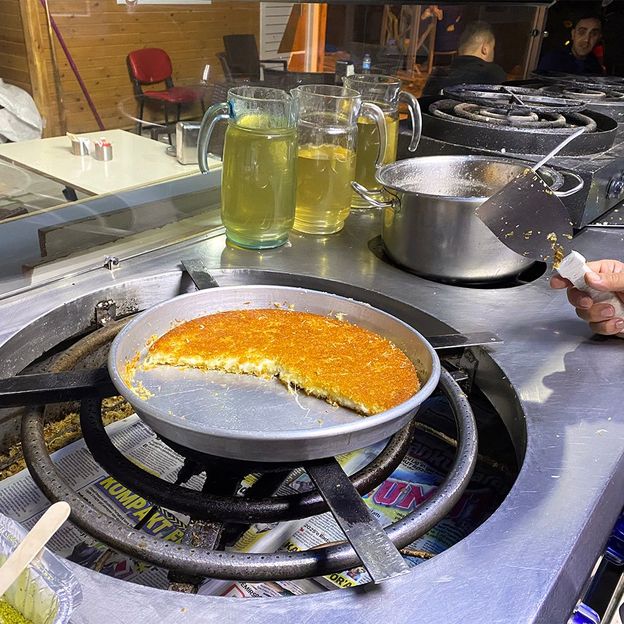
After pouring sherbet on top, künefe are served right from the tray (Credit: Gonca Tokyol)
Dinç then placed lumps of Hatay cheese on top of the cooled tel kadayıfs and pressed another layer of the crunchy dough on top. He then turned over the künefe, revealing its bottom layer, which was golden and shiny from the now caramelised eze, and transferred it to a new tray and put it back on the stove.
“I believe others who left the city [after the earthquakes] will make our künefe even more popular in other cities,” he said while waiting for the other side of the künefe to cook. “Maybe this is an opportunity for our künefe to spread [throughout] Turkey. As the ones who stayed, we can always train new ones to continue the tradition.”
Of Hatay’s 30-plus künefe shops before the earthquake, only three still operate.
“We’ll work things out, but we need some help with it,” said Dinç after bringing the künefe tray to the display outside the shop. While pouring cold sherbet over the hot künefe, he continued, “People of Antakya cannot [live] outside of here. Many left because of the conditions, but we’ll stay, they will return, and we’ll rebuild our lives again.”
After almost half an hour of work, the künefe was ready to eat. It was sugary but a little bit sour at the same time. It was soft and crispy. It tasted like the old days in Antakya, and it offered a sense of hope for the coming ones.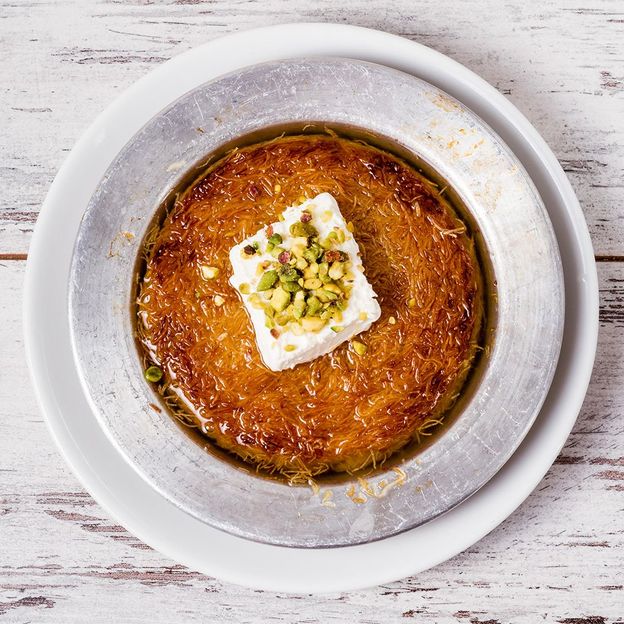
Künefe topped with kaymak and pistachios (Credit: OZMedia/Alamy)
Künefe recipe
By Engin Dinç
Serves 4
Method
Step 1
In a saucepan, prepare the sherbet by heating the water and sugar until it boils; stir occasionally so that the syrup does not stick to the bottom. When the syrup starts to boil, add the lemon juice and leave it for 5 minutes over low heat. Allow to cool.
Step 2
In a small saucepan, melt the butter over low heat. Transfer to a cup and leave at room temperature. When the butter becomes solid again, scoop out the solid parts and transfer to a small bowl; discard the watery remains left in the cup. To make the eze, mix the remaining butter with the molasses until it reaches a thick consistency.
Step 3
Unravel the tel kadayif and cut it into 1 cm (⅓ in) pieces with a knife. Spread eze to the tray (preferably a copper tray or a frying pan (about 25-30cm/10-12 inches in diameter), and place half of the tel kadayifs on the bottom of the greased tray without leaving any spaces between the pieces. Press onto the tel kadayif with your palms while rotating the tray to compress it.
Step 4
Place the tray on the stove over the lowest heat and rotate it manually every couple of minutes. When you are sure the bottom has a golden colour, remove the tray from the heat and allow it cool.
Step 5
Place the cheese on the tel kadayif layer and cover it with another layer of tel kadayif. After turning the künefe upside down on another tray, repeat the cooking process, first spreading a layer of eze onto the tray.
Step 6
Pour the sherbet onto the cooked künefe starting from the edges to the centre. Serve with pistachios or kaymak.
Courtesy: bbc

